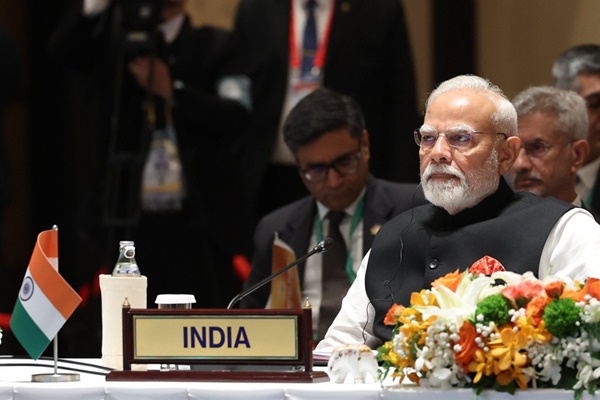
- The member nations adopted the Bangkok Vision 2030, which is the strategic roadmap aimed at fostering deeper regional integration, enhancing growth, and addressing shared challenges.
- India, at present, is much more committed to the grouping of BIMSTEC than to SAARC.
- What Pakistan is in SAARC, Bangladesh at present is in BIMSTEC, and India needs to be wary of this.
- Despite the current challenges inside BIMSTEC, this grouping is important for India as it can indulge in continuous and persistent diplomatic negotiations and dialogues with the Myanmar junta.
The sixth Bay of Bengal Initiative for Multi-Sectoral Technical and Economic Cooperation, known as the BIMSTEC Summit, was scheduled for April 4, 2025, in Bangkok, Thailand. BIMSTEC is a grouping which consists of participation from India, Myanmar, Nepal, Sri Lanka, Bangladesh, Bhutan, and Thailand. The idea of this summit is to focus on enhanced regional cooperation under the theme of “Prosperous, Resilient, and Open BIMSTEC.” This summit comes at an important time, as there has been some recent instability in the regions of South Asia, and because of this instability, the cooperation in BIMSTEC has been challenged. Also, this was the first BIMSTEC summit after the political change in Bangladesh.
BIMSTEC is an important grouping which talks for economic cooperation in the regions of South Asia, and knowing that the majority of the South Asian cooperation has been hurdled because of challenging diplomatic relations of the South Asian countries, as evident through SAARC—where Pakistan’s continuous anti-India stance has not only rejected the positive development in the region but has also challenged India’s reach in the region—and that is why for India, BIMSTEC is an alternative to the grouping of SAARC in the regions of South Asia. India, at present, is much more committed to the grouping of BIMSTEC than to SAARC.
Prime Minister Modi went to Thailand to attend the summit, where, before the BIMSTEC summit, he had a one-on-one bilateral summit with the Thailand PM Paetongtarn Shinawatra. This was the first such visit by Prime Minister Modi ever since the new Thailand Prime Minister had taken office in August of last year. In the bilateral exchange, there were many defence, cultural, economic, and security agreements that were signed between the two countries. Specifically, one attempt that has been made by the Indian side to ASEAN through Thailand is that India and ASEAN should try to review the existing Free Trade Agreement to include the current realities.
Soon after the bilateral meeting with the Thailand counterpart, Prime Minister Modi attended the BIMSTEC summit. In the BIMSTEC summit, there have been key developments in agreements that have been signed. One of the most important of them was the Bangkok Vision 2030. The member nations adopted the Bangkok Vision 2030, which is the strategic roadmap aimed at fostering deeper regional integration, enhancing growth, and addressing shared challenges. Other than this, there has been trade and transport cooperation that has been agreed upon. This trade and transport cooperation is important specifically for India because India considers Myanmar and Thailand as important BIMSTEC countries. After all, this provides India the doorway to also access the ASEAN market.
Other than this, there have been disaster relief efforts that have been made, as joint statements expressed condolences and solidarity with the affected nations. Other than this, Myanmar confirmed that 180,000 Rohingya refugees from the list submitted by Bangladesh are eligible for repatriation, marking a potential step forward in addressing the refugee crisis.
This summit was also important because this was the first time Indian Prime Minister Modi met with the interim advisor of Bangladesh, Mohammad Yunus, on the sidelines of the summit, where Indian Prime Minister Modi asked Advisor Yunus to take care of the minority population inside Bangladesh and to avoid making divisive rhetoric. The meeting was special because this was the first such visit that happened between the two sides ever since Advisor Yunus had taken over after the fall of Sheikh Hasina in August 2024. Notably, few days before to the meeting Advisor Yunus was on a state visit to China where he made a controversial opinion where he said that Bangladesh is the only sea guardian for the seven North-Eastern states of India, and he also went up to say that China should further come and use this opportunity to create manufacturing bases inside Bangladesh. This statement has not been taken well inside India, and this further reflects the existing differences between the two sides, more importantly within Bangladesh, where there has been a complete anti-India behaviour that has been adopted by the government, where there is a complete due negligence that is being taken when it comes to the minority population inside Bangladesh, as continuous systematic attacks have happened inside Bangladesh ever since the coming of Advisor Yunus.
Other than this, Prime Minister Modi also met with his Nepali counterpart, Prime Minister K.P. Oli Sharma, where bilateral relationships between the two were discussed. This was also the first such meeting between the two leaders since the return of PM Oli again as the PM in Nepal.
Though from the outlook the visit may look complete, there is a problem inside. There is a problem for India because BIMSTEC has been a great alternative to the paralysed SAARC, and India has always wanted BIMSTEC to run in a full-fledged way. But the problem inside BIMSTEC has been the differences inside the party itself. What Pakistan is in SAARC, Bangladesh at present is in BIMSTEC, and India needs to be wary of this. India needs to address the challenge, as Bangladesh’s recent anti-India and non-pragmatic diplomacy must not become the reason for the stagnation of the organisation. And that is where the responsibilities of countries like India and Thailand come into play, because it’s much more positive that the member countries be indulged in development rather than rhetoric politics.
Despite the current challenges inside BIMSTEC, this grouping is also important for India because through this grouping, India gets an opportunity to indulge in continuous and persistent diplomatic negotiations and dialogues with the Myanmar junta. Myanmar is an important region, not just for India’s BIMSTEC grouping, but it is also important for India’s national security too, as India shares a direct land boundary with Myanmar. What happens inside Myanmar has an indirect reflection on India, so India does want to indulge in continuous development to be aware of the current challenges inside Myanmar and also to solve the differences between the two countries comprehensively. As India has been saying, illegal immigrants through Myanmar have been finding their haven in India, and this issue has further been raised at the height of the Manipur crisis, where it was being seen that the Kuki grouping was not native to India.
References:
- https://www.reuters.com/world/asia-pacific/indian-pm-modi-bangladeshs-yunus-hold-first-talks-after-hasina-exit-2025-04-04
- https://www.reuters.com/world/asia-pacific/myanmar-confirms-180000-rohingya-refugees-eligible-return-says-bangladesh-2025-04-04
- https://apnews.com/article/d20d85a3a351ece0eb5668f14f0985e3
- https://www.pattayamail.com/thailandnews/bimstec-summit-in-bangkok-concludes-with-key-milestones-in-regional-connectivity-disaster-response-and-economic-integration-496460
Aayush Pal is a freelance writer on contemporary geopolitical developments. The views expressed in his work are entirely his own.
